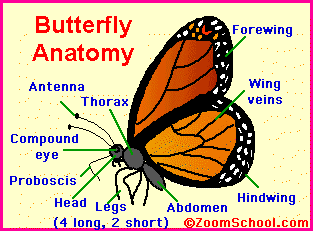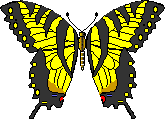|
|
 |
 |
Reply
 | |
 What is a Butterfly? What is a Butterfly?  Butterflies are beautiful, flying insects with large scaly wings. Like all insects, they have six jointed legs, 3 body parts, a pair of antennae, compound eyes, and an exoskeleton. The three body parts are the head, thorax (the chest), and abdomen (the tail end). Butterflies are beautiful, flying insects with large scaly wings. Like all insects, they have six jointed legs, 3 body parts, a pair of antennae, compound eyes, and an exoskeleton. The three body parts are the head, thorax (the chest), and abdomen (the tail end).
The butterfly's body is covered by tiny sensory hairs. The four wings and the six legs of the butterfly are attached to the thorax. The thorax contains the muscles that make the legs and wings move.
FLYING

Swallowtails are strong fliers. | Butterflies are very good fliers. They have two pairs of large wings covered with colorful, iridescent scales in overlapping rows. Lepidoptera (butterflies and moths) are the only insects that have scaly wings. The wings are attached to the butterfly's thorax (mid-section). Veins support the delicate wings and nourish them with blood. Butterflies can only fly if their body temperature is above 86 degrees. Butterflies sun themselves to warm up in cool weather. As butterflies age, the color of the wings fades and the wings become ragged. The speed varies among butterfly species (the poisonous varieties are slower than non-poisonous varieties). The fastest butterflies (some skippers) can fly at about 30 mile per hour or faster. Slow flying butterflies fly about 5 mph.
LIFE-CYCLE OF A BUTTERFLY
Butterflies and moths undergo complete metamorphosis in which they go through four different life stages. - Egg - A butterfly starts its life as an egg, often laid on a leaf.
- Larva - The larva (caterpillar) hatches from an egg and eats leaves or flowers almost constantly. The caterpillar molts (loses its old skin) many times as it grows. The caterpillar will increase up to several thousand times in size before pupating.
- Pupa - It turns into a pupa (chrysalis); this is a resting stage.
- Adult - A beautiful, flying adult emerges. This adult will continue the cycle.
| </TABLE>
DIET
 Caterpillars spend most of their time eating leaves using strong mandibles (jaws). A caterpillar's first meal, however, is its own eggshell. A few caterpillars are meat-eaters; the larva of the carnivorous Harvester butterfly eats woolly aphids. Caterpillars spend most of their time eating leaves using strong mandibles (jaws). A caterpillar's first meal, however, is its own eggshell. A few caterpillars are meat-eaters; the larva of the carnivorous Harvester butterfly eats woolly aphids.
 Butterflies and moths can only sip liquid food using a tube-like proboscis, which is a long, flexible "tongue." This proboscis uncoils to sip food, and coils up again into a spiral when not in use. Most butterflies live on nectar from flowers. Some butterflies sip the liquid from rotting fruits and a rare few prefer rotting animal flesh or animal fluids (the Harvester butterfly pierces the bodies of woolly aphids with its sharp proboscis and drinks the body fluids). Butterflies and moths can only sip liquid food using a tube-like proboscis, which is a long, flexible "tongue." This proboscis uncoils to sip food, and coils up again into a spiral when not in use. Most butterflies live on nectar from flowers. Some butterflies sip the liquid from rotting fruits and a rare few prefer rotting animal flesh or animal fluids (the Harvester butterfly pierces the bodies of woolly aphids with its sharp proboscis and drinks the body fluids).
HABITAT
 Butterflies are found all over the world and in all types of environments: hot and cold, dry and moist, at sea level and high in the mountains. Most butterfly species, however, are found in tropical areas, especially tropical rainforests. Butterflies are found all over the world and in all types of environments: hot and cold, dry and moist, at sea level and high in the mountains. Most butterfly species, however, are found in tropical areas, especially tropical rainforests.
 Many butterflies migrate in order to avoid adverse environmental conditions (like cold weather). Butterfly migration is not well understood. Most migrate relatively short distances (like the Painted Lady, the Red Admiral, and the Common Buckeye), but a few (like some Monarchs) migrate thousands of miles. Many butterflies migrate in order to avoid adverse environmental conditions (like cold weather). Butterfly migration is not well understood. Most migrate relatively short distances (like the Painted Lady, the Red Admiral, and the Common Buckeye), but a few (like some Monarchs) migrate thousands of miles.
CLASSIFICATION
 Butterflies and moth belong to the order Lepidoptera. Lepidos is Greek for "scales" and ptera means "wing". These scaled wings are different from the wings of any other insects. Lepidoptera is a very large group; there are more types of butterflies and moths than there are of any other type of insects except beetles. It is estimated that there are about 150,000 different species of butterflies and moths (there may be many more). There are about 28,000 butterfly species worldwide, the rest are moths. Butterflies and moth belong to the order Lepidoptera. Lepidos is Greek for "scales" and ptera means "wing". These scaled wings are different from the wings of any other insects. Lepidoptera is a very large group; there are more types of butterflies and moths than there are of any other type of insects except beetles. It is estimated that there are about 150,000 different species of butterflies and moths (there may be many more). There are about 28,000 butterfly species worldwide, the rest are moths.
BUTTERFLY FOSSILS
 Butterfly fossils are rare. The earliest butterfly fossils are from the early Cretaceous period, about 130 million years ago. Their development is closely linked to the evolution of flowering plants (angiosperms) since both adult butterflies and caterpillars feed on flowering plants, and the adults are important pollinators of many flowering plants. Flowering plants also evolved during the Cretaceous period. Butterfly fossils are rare. The earliest butterfly fossils are from the early Cretaceous period, about 130 million years ago. Their development is closely linked to the evolution of flowering plants (angiosperms) since both adult butterflies and caterpillars feed on flowering plants, and the adults are important pollinators of many flowering plants. Flowering plants also evolved during the Cretaceous period.
|
 First First
 Previous
No Replies
Next Previous
No Replies
Next Last
Last
|
|
|
 Free Forum Hosting
Free Forum Hosting